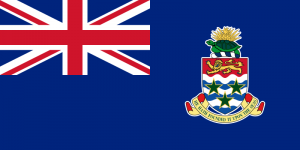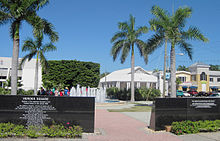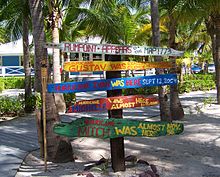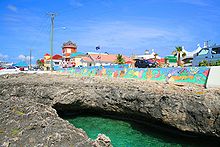Cayman Islands

Cayman Islands National Archives
As one of the keepers of Cayman’s history, the Cayman Islands National Archive is filled with books, newspapers, magazines, video recordings, diaries, photos, and a host of other documents that recreate the past. Join us as we travel backward in time, courtesy of our visit to the Archive. Discover why keeping records is important and how you can track branches of your family tree.
The Cayman Islands (/ˈkeɪmən/ or /keɪˈmæn/) are a British Overseas Territory located in the western Caribbean Sea. The territory comprises the three islands of Grand Cayman, Cayman Brac and Little Cayman, located south of Cuba and northwest of Jamaica. The Cayman Islands are considered to be part of the geographic Western Caribbean Zone as well as the Greater Antilles. The territory is a major world offshore financial centre.
The Cayman Islands remained largely uninhabited until the 17th century. While there is no archaeological evidence for an indigenous people on the islands, a variety of settlers from various backgrounds made their home on the islands, including pirates, refugees from the Spanish Inquisition, shipwrecked sailors, and deserters from Oliver Cromwell‘s army in Jamaica.
 Cayman Islands National Museum, George Town, Grand Cayman.
Cayman Islands National Museum, George Town, Grand Cayman.
The first recorded permanent inhabitant of the Cayman Islands, Isaac Bodden, was born on Grand Cayman around 1661. He was the grandson of the original settler named Bodden who was probably one of Oliver Cromwell’s soldiers at the taking of Jamaica in 1655. England took formal control of the Cayman Islands, along with Jamaica, as a result of the Treaty of Madrid of 1670. Following several unsuccessful attempts at settlement, a permanent English-speaking population in the islands dates from the 1730s. With settlement, after the first royal land grant by the Governor of Jamaica in 1734, came the perceived need for slaves. Many were brought to the islands from Africa; this is evident today with the majority of native Caymanians being of African and English descent. The results of the first census taken in the islands in 1802 showed the population on Grand Cayman to be 933 with 545 of those inhabitants being slaves. Slavery was abolished in the Cayman Islands in 1834. At the time of abolition, there were over 950 slaves owned by 116 Caymanian families.
The islands continued to be governed as part of the Colony of Jamaica until 1962, when they became a separate Crown colony while Jamaica became an independent Commonwealth realm.
 The Heroes Square in the centre of George Town, which commemorates Cayman Islands’ war dead. The Legislative Assembly building is at the left.
The Heroes Square in the centre of George Town, which commemorates Cayman Islands’ war dead. The Legislative Assembly building is at the left.
The Cayman Islands historically have been a tax-exempt destination. On 8 February 1794, the Caymanians rescued the crews of a group of ten merchant ships, including HMS Convert, an incident that has since become known as the Wreck of the Ten Sail. The ships had struck a reef and run aground during rough seas. Legend has it that King George III rewarded the island with a promise never to introduce taxes as compensation for their generosity, as one of the ships carried a member of the King’s own family, his son Prince William, Duke of Clarence and St Andrews. While this remains a popular legend, the story is not true.
However, whatever the history, in practice the government of the Cayman Islands has always relied on indirect and not direct taxes. The islands have never levied income tax,capital gains tax, or any wealth tax, making them a popular tax haven.
On 11–12 September 2004 the island of Grand Cayman, which lies largely unprotected at sea level, was hit by Hurricane Ivan, creating an 8-ft storm surge which flooded many areas of Grand Cayman. An estimated 83% of the dwellings on the island were damaged including 4% requiring complete reconstruction. A reported 70% of all dwellings suffered severe damage from flooding or wind. Another 26% sustained minor damage from partial roof removal, low levels of flooding, or impact with floating or wind driven hurricane debris. Power, water and communications were disrupted for months in some areas, as Ivan was the worst hurricane to hit the islands in 86 years. Grand Cayman began a major rebuilding process and within two years, its infrastructure was nearly returned to pre-hurricane status. Due to the tropical location of the islands, more hurricane or tropical systems have affected the Cayman Islands than any other region in the Atlantic basin; it has been brushed or directly hit, on average, every 2.23 years.
Geography
 Map of the Cayman Islands, showing the three main islands about 120 kilometres [ 75 mi ] apart.
Map of the Cayman Islands, showing the three main islands about 120 kilometres [ 75 mi ] apart.
Geography of the Cayman Islands
The Cayman Islands are located in the western Caribbean Sea and are the peaks of a massive underwater ridge, known as the Cayman Ridge (or Cayman Rise). This ridge flanks the Cayman Trough, 6,000 m (20,000 ft) deep which lies 6 km (3.7 mi) to the south. The islands lie in the northwest of the Caribbean Sea, south of Cuba and west of Jamaica. They are situated about 700 km (430 mi) south of Miami, 366 km (227 mi) south of Cuba, and about 500 km (310 mi) northwest of Jamaica. Grand Cayman is by far the biggest, with an area of 197 km2 (76 sq mi). Grand Cayman’s two “Sister Islands”, Cayman Brac and Little Cayman, are located about 120 km (75 mi) east north-east of Grand Cayman and have areas of 38 and 28.5 km2 (15 and 11.0 sq mi) respectively.
All three islands were formed by large coral heads covering submerged ice age peaks of western extensions of the Cuban Sierra Maestra range and are mostly flat. One notable exception to this is The Bluff on Cayman Brac’s eastern part, which rises to 43 m (141 ft) above sea level, the highest point on the islands.
Terrain is mostly a low-lying limestone base surrounded by coral reefs.
Fauna – List of mammals of the Cayman Islands
The mammalian species in the islands include the introduced Central American agouti and eight species of bats. At least three now extinct native rodent species were present up until the discovery of the islands by Europeans. A number of cetaceans are found in offshore waters.
Cayman avian fauna includes two endemic subspecies of Amazona parrots: Amazona leucocephala hesterna, or Cayman Brac parrot, native only to Cayman Brac, and Amazona leucocephala caymanensis or Grand Cayman parrot, which is native to the Cayman Islands, forested areas of Cuba, and the Isla de la Juventud. Little Cayman and Cayman Brac are also home to Red-footed and Brown Booby birds.
Among other notable fauna is the endangered blue iguana, which is endemic to Grand Cayman.
Climate
 Signs at Rum Point commemorating landed and near-miss hurricanes. – Climate of the Cayman Islands
Signs at Rum Point commemorating landed and near-miss hurricanes. – Climate of the Cayman Islands
The Cayman Islands have a tropical marine climate, with a wet season of warm, rainy summers (May to October) and a dry season of relatively cool winters (November to April).
A major natural hazard is the tropical cyclones that form during the Atlantic hurricane season from June to November.
On 11 and 12 September 2004, Hurricane Ivan struck the Cayman Islands. The storm resulted in two deaths, and caused great damage to the infrastructure on the islands. The total economic impact of the storms was estimated to be $3.4 billion.



